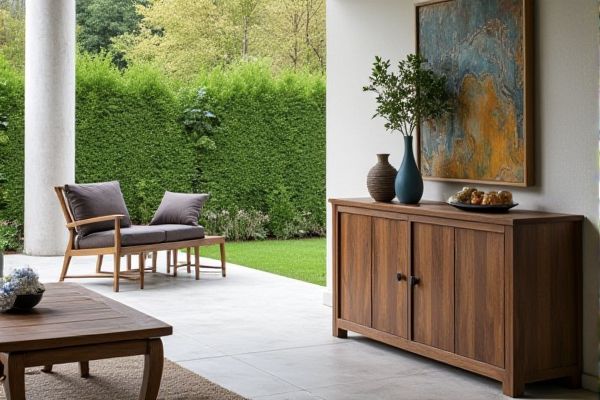
Outdoor console tables provide ample surface space and storage options, perfect for organizing your outdoor essentials along walls or behind seating areas, while outdoor side tables offer compact convenience, ideal for holding drinks or small items next to chairs. Discover which option best suits your outdoor living needs by reading the rest of the article.
Table of Comparison
| Feature | Outdoor Console Table | Outdoor Side Table |
|---|---|---|
| Size | Large, elongated surface | Small, compact surface |
| Primary Use | Display items, storage, serving | Holding drinks, snacks, small items |
| Placement | Against walls, behind sofas, entryways | Beside chairs, sofas, patio seating |
| Storage Options | Often equipped with shelves or drawers | Usually no storage, flat surface only |
| Design | Tall, narrow, decorative | Short, portable, versatile |
| Material | Weather-resistant wood, metal, or composite | Weatherproof metals, plastics, or wood |
| Functionality | Multipurpose for decor and utility | Convenient for immediate use items |
Introduction to Outdoor Console Tables and Side Tables
Outdoor console tables offer a versatile surface ideal for displaying decor or serving refreshments on patios, blending functionality with elegant design. Outdoor side tables provide compact, easily movable surfaces perfect for keeping drinks or personal items within reach during outdoor relaxation. Your choice between these tables depends on space availability and specific usage needs for your outdoor living area.
Key Differences Between Outdoor Console Tables and Side Tables
Outdoor console tables are typically larger, designed for placement against walls or behind sofas, providing ample surface area for decor or serving. Outdoor side tables are smaller, portable, and intended to sit beside seating for easy access to drinks or personal items. Your choice depends on spatial needs and functional use, with console tables offering more storage and side tables prioritizing convenience.
Design and Aesthetic Comparison
Outdoor console tables typically feature elongated designs that provide ample surface space for decorative items or entertaining essentials, creating a striking focal point on patios or decks. Outdoor side tables are generally smaller and compact, designed to complement seating areas with a functional yet unobtrusive profile that blends seamlessly into various outdoor aesthetics. Your choice depends on whether you prefer a bold statement piece or a versatile, space-saving addition to your outdoor living area.
Functional Uses in Outdoor Spaces
Outdoor console tables provide ample surface area ideal for serving food, displaying plants, or organizing grilling accessories, making them perfect for patios and garden entertaining zones. Outdoor side tables offer compact, portable surfaces ideal for placing drinks, snacks, or small decor items next to seating areas, enhancing convenience and comfort. Both table types improve outdoor functionality, but console tables prioritize workspace and storage, while side tables focus on accessibility and mobility.
Material Choices and Durability
Outdoor console tables often feature sturdy materials like treated wood, metal, or weather-resistant wicker designed to withstand exposure to sun, rain, and humidity, offering long-lasting durability. Outdoor side tables typically use similar weatherproof materials but are generally smaller and lighter, making them easier to move while still providing resistance to the elements. Choosing the right material ensures your outdoor furniture maintains its appearance and functionality, protecting your investment from harsh outdoor conditions.
Size, Shape, and Space Considerations
Outdoor console tables are typically larger, rectangular, and designed to maximize narrow spaces along walls or patios, providing ample surface area for decor or serving items. Outdoor side tables are smaller, often round or square, offering flexible placement next to seating for easy access without dominating the space. Choose the table that fits Your spatial layout and functional needs, balancing size and shape with available outdoor area.
Storage and Organization Features
Outdoor console tables typically offer more extensive storage and organization features, such as multiple shelves, drawers, and compartments that provide ample space for storing gardening tools, outdoor accessories, and decor items. Outdoor side tables usually have limited storage options, often featuring a single flat surface or a small shelf, making them ideal for holding drinks or small items but less suitable for organizing larger items. Choosing between the two depends on the need for storage capacity versus compact convenience in outdoor spaces.
Versatility in Outdoor Decor
Outdoor console tables offer a versatile design that can serve multiple functions such as extra seating, surface space for plants, or a buffet station during gatherings. Outdoor side tables are compact and perfect for holding drinks or small items next to seating areas, enhancing convenience without taking up much space. Your choice depends on the need for multifunctional furniture versus a simple, space-saving solution to complement your outdoor decor.
Maintenance and Care Requirements
Outdoor console tables require regular maintenance such as cleaning with mild soap and water to prevent dirt buildup and occasional sealing or oiling for wood finishes to protect against weather damage. Outdoor side tables, often smaller and more lightweight, also need routine cleaning but typically demand less effort for upkeep due to their compact size and simpler design. Both types benefit from protective covers during harsh weather to extend their lifespan and maintain aesthetic appeal.
Choosing the Best Table for Your Outdoor Area
Outdoor console tables offer a versatile design with ample surface space, ideal for displaying decor or serving food during gatherings, making them perfect for larger patios or entryways. Outdoor side tables provide a compact, functional solution for placing drinks, snacks, or small items next to seating areas, enhancing convenience without occupying much space. Selecting between these options depends on the available area and the intended use, balancing surface capacity with spatial efficiency to maximize outdoor comfort and style.
 homyna.com
homyna.com